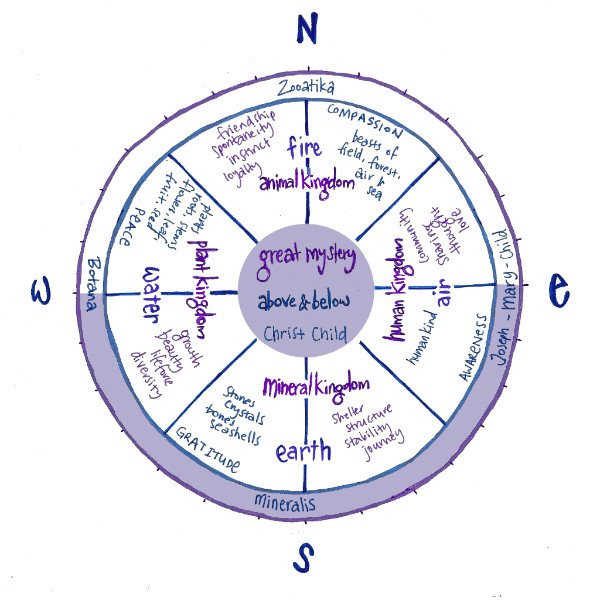On how Goddess Inspired Advent came to be...
...and what it could become at your house.
The Goddess Inspired Advent draws on the elements : Air, Water, Fire and Earth to tell the story of what happens when the Sun and Moon give birth to new life. For four Mondays (moon-days) leading up to Xmas or the Solstice, another layer of the story is shared.
This is a long and diverse article about how I came to create the Goddess Inspired Advent, the meanings and depths of the individual elements of the story, and how you could use the advent at your house. It is a duplicate of the information in the introductory email for the Goddess Inspired Advent program.
[product sku="GIA"]
The Nativity Story
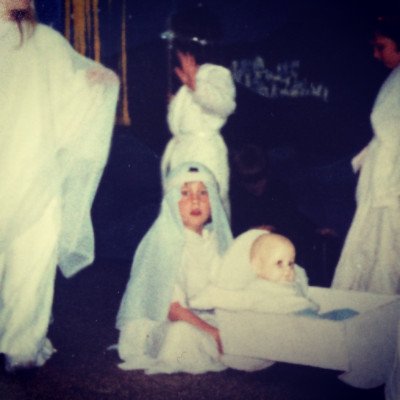
I went to Anglican Sunday School throughout childhood. I loved the idea of ceremony and magick and I loved stories. At approximately age six, I decided this "God thing" was a crock; I had prayed for a bike for Christmas, which I didn't receive but another girl DID get a bike - and her family didn't even go to Church! I would listen to the stories in Sunday School, play them out in my mind, decide which characters were believable and not, then choose which were worth remembering. Even as a little kid I was creating my own version of Divinity and faith.
My mother, also not very convinced on the "God thing", had a seemingly unrelated obsession with the Nativity of Christ. She crafted her own set of figures and would set up a procession in the living room each year on the 1st of December. I loved those ceramic figures much more than the plastic evergreen tree that hung with tacky plastic ornaments. To me, the figures were something I could relate to - they were human. They held the story of struggle and change and hope. I could see the purpose of the Nativity, because the stories were in the Christmas Carols and the church plays. I could never get my head around the tree - how was it relevant to Jesus?
When I hit teenage world my mother found the New Age and I found Witch Craft. Suddenly, the seasons made sense. The Wiccan Wheel of the Year explained the origins of Christmas and Easter so that all the things I loved about those festivals came real, and the rest fell away with ease. Christ and his family took a back seat to the Goddess while I learned everything I could about She of 10,000 Names and Faces. Yet, whenever Christmas came around, I still observed the story of Christ - the Cosmic Man and Shaman (Dierkes, 2012) who was a teacher of compassion, gratitude and how to believe in magick.
When my children were born, I rejected most mainstream customs. Santa was sacked. We ignored Easter in March/April. Halloween was definitely off the list. In the meantime I organised Samhain parties, held Spring Gatherings and attended Midwinter celebrations. I embraced the Wheel of the Year (Spiral of the Sabbatts ecourse, 2017) AND I kept Christmas. Our Christmas looked very different to anyone I knew though, observing the story of the birth of Christ Who is Magickal and Good. We don't talk about him being the son of God, or the Saviour of the world blah blah blah. We simply celebrate the goodness of humanity.
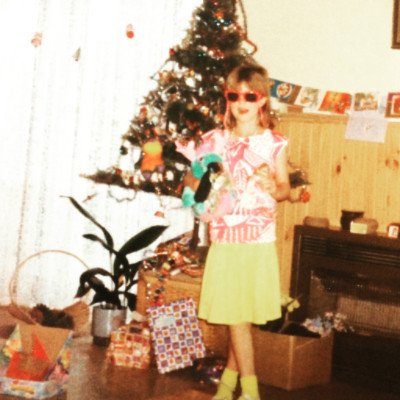
Christmas in our home has become a reminder and celebration of the Goodness in people. Woven into our family customs are the virtues of Being Real Humans. The story of Christ is a symbol, and Advent is the practice and ceremony of that celebration.
What is Advent?
Advent is typically a four-to-five week celebration known to be observed in many Western Christian churches. It is a time of expectation, waiting patiently, and preparation for the celebration of the birth of Jesus at Christmas time.
The word "advent" comes from the Latin adventus and means "a coming, approach, arrival" and shares roots with the word "adventure" : about to happen. For Christians, the season of Advent anticipates the coming of Christ, and details the bible stories of Mary and Joseph's courageous journey to Bethlehem and the birthing of Jesus. Historians believe advent has been celebrated by the Church since somewhere around the 5th to the 7th Century B.C.E.
In more recent years the Advent celebration has been embraced by the Waldorf education system, developed by Rudolf Steiner. Waldorf families observe a version of advent guided by this verse, attributed to Steiner :
The first light of Advent is the light of stone,Light that lives in crystals, seashells, and bones.
The second light of Advent is the light of plants,Plants that reach up to the sun and in the breezes dance.
The third light of Advent is the light of beasts,All await the birth, from the greatest and in least.
The fourth light of Advent is the light of humankind,The light of hope that we may learn to love and understand.
Advent commences on the fourth Sunday before Christmas, and the sixth Sunday before Christmas in some Catholic traditions. Some churches have complex ceremony and liturgy celebrating advent.
In modern mainstream culture, the word "advent" has become synonymous with a calendar that counts down the days in December until Xmas. Familiar are the store bought paper calendars, with images of Santa and his reindeer, where little doors open revealing a confection each day. Of course there are other styles of advent calendar; some open to reveal toys, kind words, gifts and anything else that you could think of.
In the northern hemisphere, the celebration of advent is tied to the coming of Midwinter. The images used to define Christmas in our Western culture; snow and evergreen trees, roast dinners and oranges stuffed with cloves; have their roots in much older pagan traditions of celebrating the seasons.
Midwinter is the festival of the coming light. In the deep winter of Europe, it is dark throughout the day and the land is covered in snow. Nature is sleeping. Midwinter Solstice (meaning "the sun stands still") was once known as the birth of the Sun. Where the nights can get no longer, and the days no shorter, the pendulum swings all the way, and then must begin to swing back in the opposite direction, bringing the sun once again. (For more information about the celebrations of the Seasons, see my ecourse Spiral of the Sabbatts, due out in 2018).
So, in the lead up to Midwinter, in the darkest time of the year, it is known that the light is returning, a cause for great celebration. You can just imagine the anticipation of a time before electric lights and gas heating, where the necessary tending of the fires for light and warmth could become a ritual of seasonal attunement and deep importance to the calendar of the entire year.
In the Southern Hemisphere, mainstream culture (which of course gets its foundation from invading Europeans) still celebrates Christmas in December, with all the early pagan symbols in tact. Even though it is the height of summer in Australia, people still dress in big red suits and windows are painted with snowmen. Most people don't know that Christ was not born in December, but that his "birthday" was changed for political reasons in the 4th Century B.C.E. - before that, Midwinter was a celebration of the birth of the Sun. Now, in Australia we celebrate customs that originate with the birth of the Sun, at the exact time when the Sun is at its fullest strength : Midsummer!
Midsummer is associated with a completely different set of symbols and traditions. In the same European cultures, Midsummer is the time when the nature spirits celebrate the full bloom of nature and everything alive. Images of faeries dancing in circles, bright flowers, abundance, and outdoor parties are all the rage for this time of year.
The Midsummer tradition of leaving milk and honey for the faeries comes from a time and place where milk was seen as an abundant and sacred form of nutrition, and honey was a rare delicacy. Before agriculture, milk was the ultimate symbol of the human mother, she who gives life and grows life from her own body - magick! Before a time when bees were "kept", they were wild creatures, who reminded humans of the medicine of working as a collective, and survival of the Mother/Queen line. Honey was difficult to gather, sacred, and used mostly for its healing properties.
Of course in Midsummer we are not searching for the light to return : rather it's here with flourish and abundance. In Australia in particular, the warmth of the Sun is overwhelming at this time of year. We do not crave roast dinners or stories inside around the fireplace. Instead we desire the cool places, to swim in the day and stay up with friends late into the night. And so, it makes sense to develop our customs to reflect this natural rhythm.
Alas, the Christmas in December cult is insidious in our society, and even the most out-there, off the grid, R.E.b.E.L. families find it difficult to avoid the hype at this time of year. Many of us learn that entirely excluding the mainstream customs is unmanageable, so we adapt, re-frame and change the way we celebrate in order to bring authenticity and meaning into a culture that has forgotten.
This re-framing needs not to affect anyone else's ideas of celebration and religion. The most empowering forms of re-framed celebrations are personal, specific and individual to each family. This Goddess Inspired Advent package is one of many ways you can explore different customs and create your own form of celebration.
Goddess Inspired Advent
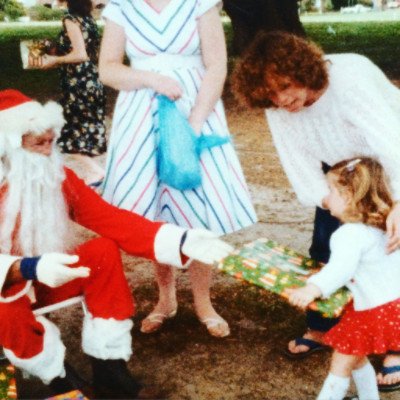
From the northern custom of the growing light of advent, we may re-frame our understanding to reflect a light that grows within us, growing outward, embracing space and place. This light is the light of community, of togetherness, of peace and kindness and gratitude - of all the things that make us happy and fulfilled humans. The lights of advent are in fact a reflection of your own inner light, streaming to the four corners of the world, filling every space with your beauty and intense awesomeness, in a process of creation of the world you wish to live in.
How could there be a better time for creating the world you wish for, than when light is at its peak?
If you live in the Northern Hemisphere, you can still use the Goddess Inspired Advent for your season. Where we in the south are aware of our light that shines from within, you can pay attention to your light that is growing within. Where we are aware of the abundance and fruits of the Mother, you can pay attention to the potential and hope of the Mother. It's all relevant because its all part of a continuum - a cycle of birth, growth, death and rebirth that is ever unfurling : the Spiral-Within-the-Circle that follows the Rhythm of Life.
I use the word "Goddess" as an overarching concept of Universal Life. She Who is of 10,000 names is also nameless. She is not The Goddess, nor is she A Goddess. She is simply Goddess. (Five Faces of Self Crafting ecourse, 2013) "She" is the unmistakable feminine creative energy that births life. Gender is undeniable, seen in every living mammal on this planet. As a human mammal, I use the term Goddess synonymous with Life because it is the feminine that gives and creates life. This isn't about religion. It's about the Universal Truth that everything that lives is created by the force of nature that is unexplainable.
In our humanness, without that explanation, we seek ways to understand and that's where meaningful customs have their relevance. Religion doesn't own these customs because they can only be authentic when we embody them for ourselves. Meaningful customs must be individual and unique - a personal realationship with the great Universal She Power : Goddess, that we develop within and without. This is why Goddess Inspired Advent was created. Our mainstream culture is at a point where convenience is chosen to the detriment of all things. We have been led to believe that convenience creates ease, but ease for what? Ease for the Earth? Ease for community? Ease for relationships? True ease comes with the living of the Rhythm of Life. It's about living authentically. Being Authentic creates ease. #authenticityoverconvenience
You may have a different name or word for what I term "Goddess" and that is totally appropriate. I will continue to use the term Goddess, and you will know that that word means the same as whatever your word is. Okay?
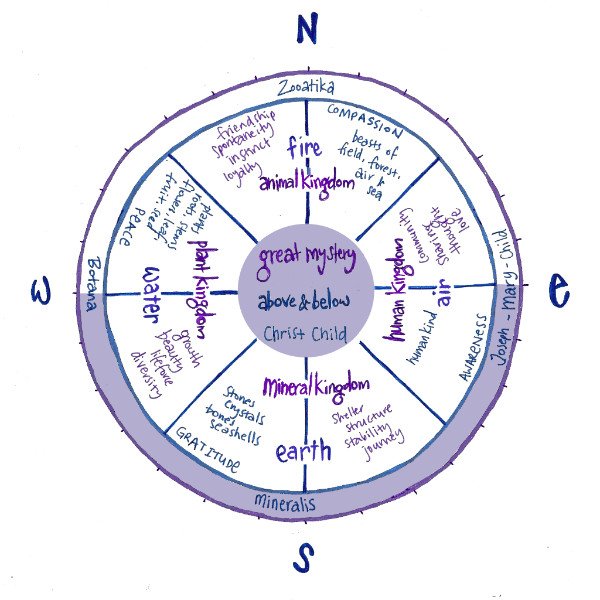
Themes of Advent
Cultures develop ways of understanding the world through symbol and metaphor, because the real world is so much bigger than we can possibly fathom. Nature is a complex continuum that includes everything, excludes nothing and makes no judgement of how it unfurls.
As humans we use words, images, colours, sounds, scents and movement to express our awareness of the world. The need for expression is classified as a Fundamental Human Need and research shows that without close meaningful relationships with people (House, Landis & Umberson, 1988; Cohen, 2004) AND nature (Maller, Townsend, Pryor, St Leger, 2005; de Vries, Verheij, Groenewegen, Spreeuwenberg, 2003), we will not thrive as individuals. Thriving as individuals is the intention of Self Crafting.
The culture of the Institute of Self Crafting is explained by the map of the Rhythm of Life (Rhythm of Life ebook, 2016). Awareness layers again and again on this map - everything fits as a reflection of Nature, Goddess and our Individual Self. I find that when I work with the map, everything is in flow. When I work with the flow everything has meaning - I know where it fits in the world and where my contributive essence fits. When I know where I fit, the path of Self Crafting is true ease.
The Rhythm of Life is mapped as four quadrants that intersect in a midpoint that forms the axis of all things. This axis is both the beginning and end. It is the centre of the Spiral, the centre of the Circle, the centre of the Universe. Sometimes I will refer to it as "The Centre of the Centre of the Centre of the Universe".
The layers of the Rhythm of Life show up again and again at the Institute for Self Crafting. Each course, each item, each workbook details another layer of the map. When each layer is placed over the next, it forms a complex wheel of information that informs all of life. Goddess Inspired Advent draws on the same map. If you have never seen the Rhythm of Life map before, there is no need to worry. The information below is for people who like to geek out about such things, but it doesn't matter if you don't get it all at once. This information is built into the chapters of the stories you will receive.
One of the many great things about symbol is that we are hard wired with the understanding of authentic meaning, even when we are not entirely aware of it. For example, most people can name how they feel about a specific colour, or what an animal might be representative of when we look at their natural behaviours (above I mentioned bees and their teaching of community). Symbol lives within us as the language of Nature. It is our birth rite. Symbol tells story. I find that knowing the meaning of the symbol allows the deeper awareness of how I embody the authenticity of the story.
First Quadrant Correspondences for Goddess Inspired AdventSouth - Earth - Mineral Kingdom -Gratitude - shelter, structure, stability, paths to new adventuresMineralisstones, crystals, seashells and bonesSecond Quadrant Correspondences for Goddess Inspired AdventEast - Air - Human Kingdom -Awareness - community, sharing, thought, loveMary, Joseph and the small child in the stableHumankindThird Quadrant Correspondences for Goddess Inspired AdventNorth - Fire - Animal Kingdom -Compassion - body and form , instinct, loyalty, friendshipZooatikabeasts of field, forest, air and seaFourth Quadrant Correspondences for Goddess Inspired AdventWest - Water - Plant Kingdom -Peace - growth, beauty, life force, diversityBotanaplants, roots, stem, leaf, flower, fruitCentre Axis Correspondences for Goddess Inspired AdventWithin, Above, Below - Birth - Great Mystery -Being - Love, truthChrist child
You will notice that in the Advent Story our characters visit each of the Quadrants in reverse order to the usual flow of the Rhythm of Life. Mary journeys from the South, to West, to North, to East to centre carving a reverse spiral into the place of Birth, Growth, Death and Rebirth. This centre axis is the void from which all things come. It is akin to turning within when everyone else is pushing onward. Like the journey of the labyrinth we walk one direction and must come out the opposite way. Birthing is a time outside of time and a space outside of space - between the worlds. From this place in the centre, the family will journey forward again in the flow of the Rhythm of Life and the seasons.
Mondays
Typically advent candles are lit on Sundays because it is the day of the Sabbath. I have always delivered my advent on Mondays because that is the day of the Moon, and it's a day when our family are at home. You could deliver any day that suits you.
[product sku="GIA"]
The Dolls
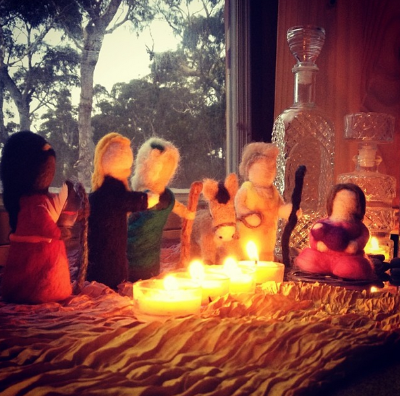
I love making dolls. In magickal work a doll may be representative of a person, a feeling, yourself… I believe we relate to dolls because it's obvious - they look like, dress like, stand like we do. It's believed that stone age humans carved human figures to celebrate and revere the amazing wonders of life. Dolls are art and expression. Making dolls is in our DNA.
I once read about a custom from England where poor women would carry the figures of the nativity with them, displaying them to people they passed. It was thought to be a blessing to witness the dolls and wealthy people would give the women a coin, or a gift in gratitude. It was considered very bad luck to ignore the beggar woman.
This tidbit, like so many little strange forgotten customs holds my inspiration. In the above paragraph I have given you three sentences laden with symbol : the beggar woman, dolls, gifts, coins, journeys, crossing paths, fortune… we find meaning in every custom.
Dolls can be imbued with sacred properties, filled with herbes and decorated with curios. The colours chosen may have significance, or the time of day on which they are made, or any other detail… Making dolls is a process of Spell Crafting (Spell Crafting Foundations, 2017).
My Goddess Inspired Advent dolls are needle felted especially for this story. They are simple and unadorned on purpose, to allow room for imagination. We set our dolls each December and they inevitably get moved, knocked over by cats and played with by children. They are not a precious item to be untouched and revered. They are a part of everyday life, a point of focus to be noticed, attended to and loved in the moment.
Whether you make your own dolls, purchase a set, or use the images that come in your Chapters, know that telling any story with the help of visual props adds layers and dimensions that are much more satisfying for little people and adults alike.
Celebrating in your home
Customs become meaningful when they filter into our everyday life. Does it feel like a birthday without a cake? Decorating your home for the Season is a simple way to acknowledge the Rhythm of Life and embrace the flow in your body. Whether you designate one little shelf on a wall, an altar table or an entire house makeover, finding a way to visually define the season will add to your celebrations.
Some people like to add curios and other objects to a special place each day, others prefer to take away something each day as the time of "birth" gets closer. Appropriate objects would be relevant to the Quadrant : rocks and crystals for the week of the Stone People, flowers and leaves for the week of the Standing People etc.
In mainstream culture, this is a time for songs about the Nativity. Perhaps you can rewrite some of the old songs to reflect the way you celebrate...
Advent Candles
The simplest decoration for advent involves a circular shape with four candles. A wreath of vines and flowers from your garden could make the circle. Or, perhaps you will use sticks to mark out a shape. The circle is important because it is a symbol of the eternal - no beginning and no end, the Circle represents the everlasting journey of Being. The four candles represent the Quarters of the Circle, the quadrants of the Rhythm of Life. As we light each candle we are reminded of the virtues and gifts each element brings.
I like to create a Spiral-Within-the-Circle. The Spiral reminds me that the journey is not only everlasting and eternal, but that it also continues to spiral deeper each turning. I am always becoming more aware, always deepening my understanding, always coming closer to the Centre of the Centre of the Centre of the Universe. Like a dance, the spiral allows us to come in deep, and then reach out wide again when we need, forever shifting and changing with the energy of place and space and whatever is happening right now.
As each week draws us closer to celebration, the light of the Spiral-Within-the-Circle grows and reminds us that gratitude, peace, compassion and awareness are ever growing. We light the candles as part of the anticipation - something is happening and that's exciting. The light shines out all the icky, grotty stuff and the beauty grows with it. We can meditate on the Universal Truth of Being.
In the centre of the Spiral-Within-the-Circle, I place the fifth candle. This represents the coming together of all things, the intersecting points of the map, She Who spins the great Wheel of Life and holds us all safe within. This candle is lit at the Solstice, or Christmas if you're doing it that way. Keeping this "Mother candle" somewhere safe and bringing it out each year reminds us that we are keeping the light aglow. Each year we share the light of the same candle and celebrate the deeper awareness of the Spiral-Within-the-Circle.
Advent Tree
The Jesse Tree is a Christian Advent tradition which may be related to the pre-Christian tradition of bringing a tree inside for the deepest part of winter, to bring nature inside, now known as the Christmas Tree. The Jesse Tree is decorated over time with biblical figures such as Noah and Mary, and serves as a teaching tool for children as they prepare through advent. This could be enacted similarly for anything you'd like to remind your family of, including family members, special events that happened throughout the year, or things you are grateful for.
Over the years our family has had different trees, but mostly they are made by bringing a fallen eucalyptus branch inside and hanging sparse decorations. One year I made little notes each day of advent about things I was grateful for and opened them all on New Year's Eve as a way to start the year with good vibes.
Advent Calendar
Create your own Calendar by hanging recycled small bags and boxes from a branch. Inside each of the bags you could place gifts, kind words, activity ideas or anything else. Open one per day, like any other advent calendar.
In our Goddess Inspired Advent Doll Set, we keep a collection of small river pebbles to place in the procession. There are as many rocks as there are days in the advent. Each day we take one pebble away and move the Moon Priestess and her Sun Priest closer to the place where she will birth.
Combining Advent, Solstice and Christmas
When my children were little they were visited by a Christmas Faerie. She would come on Christmas Eve with gifts to give her thanks of the gifts she herself received on the Midsummer Solstice a few days before. We always left Milk and Honey for the Nature Spirits and Faeries at Midsummer to give thanks of all the things they give us throughout the year. Each family member would stand at the plates of milk and honey and say what they were thankful for.
Combine advent with the Midsummer celebration of the Nature Spirits and Fae by theming your advent activities to the nature spirits - eg. in the first week go out on a Gnome hunt for the Earth element. In the second week decorate your trees outside in the garden for the faeries' summer parties etc.
In the Northern Hemisphere, keep to the traditional Yule themes of the birth of the Sun by preparing for the big event coming up to the Solstice - make the time between Solstice and Christmas as the "baby moon" period where gifts are offered to the Sun and Mama Earth. On Christmas Day you might open gifts that have been delivered in thanks by the Winter Shaman (aka Santa Claus).
Also, see my Twelve Days of Winter's Tide at the Institute for Self Crafting for a modernised Goddess Inspired guide to celebrate Yule.
A word about #authenticityoverconvenience

Meaningful customs require forethought and connection. The Goddess Inspired Advent is not something you will find in shops, because it is not a quick, consumer applied filler for a meaningful life. I ask you to Pay Your Attention to the ethics and sustainability of any of your choices around your family rituals and traditions.
What will it take for our culture to real-eyes patience instead of want-it-right-now?
When creating your customs with the Goddess Inspired Advent, please keep in mind how you are using resources. This is a chance to set an example to your family for living a fully authentic life that is meaningful on every level, in every layer. The Season is after all, about preparation and a gentle build-up to something magickal… Allow your celebrations and customs to mirror this wisdom.
Want decorations for advent? Will you head to the Dollar Store and spend $30 on plastic junk made by someone on the other side of the world in a dangerous factory that chugs pollution into the water supply…? Or can you wait a few weeks, months or even until next year to spend the same $30 plus a bit extra on an ethically made, creation that can be passed on to your children's children?
#authenticityoverconvenience starts with You. [product sku="GIA"] ReferencesBakerboljkovac., H. (2013). Five Faces of Goddess Retrieved from http://instituteforselfcrafting.com/u2/Bakerboljkovac., H. (2016). The Rhythm of Life : a map for Self Crafting Retrieved from http://instituteforselfcrafting.com/sacred-grove/Bakerboljkovac., H. (2017). Spell Crafting Foundations Retrieved from http://instituteforselfcrafting.com/u10/Bakerboljkovac., H. (2017). Spiral of the Sabbatts. Retrieved from http://instituteforselfcrafting.com/u8/Cohen, S. (2004). Social Relationships and Health, American Psychologist, 676-684.de Vries, S., Verheij, R. A., Groenewegen, P. P., Spreeuwenberg, P. (2003). Natural environments - healthy environments? An exploratory analysis of the relationship between greenspace and health. Environment and Planning A, 35, 1717-1731. doi:10.1068/a35111Dierkes, C. (July, 2012). Jesus the Shaman Retrieved from http://beamsandstruts.com/articles/item/1014-jesus-the-shamanHouse, J. S., Landis, K. R., Umberson, D.,. (1988). Social Relationships and Health Science, 241(4865), 540-545.Maller, C., Townsend, M., Pryor, A., Brown, P., St Leger, L. (2005). Healthy nature healthy people : 'contact with nature' as an upstream health promotion intervention for populations. Health Promotion International, 21(1), 45-54. doi:10.1093/heapro/dai032

